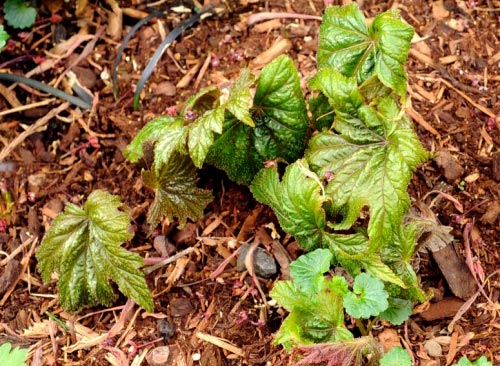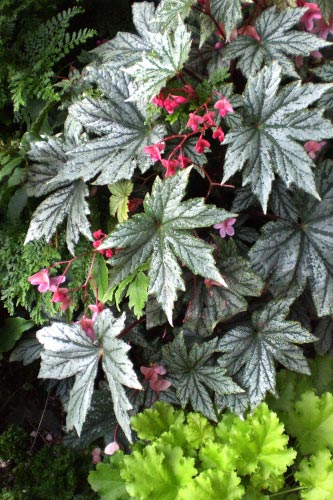Enter "Hardy Begonias" on Google™ and you will find that 99% of the entries point to a single species; Begonia grandis (syn B. evansiana). From the frozen heights of Machu Picchu in the Andes to exotic locales in China, new species are surfacing that show promise in the hardy arena. There are truly only a handful of hardy species among the 1,500 species of Begonias. So, how does one find them? Research and exploration.
In my Begonia talk, I show a page taken from the Flora of China (Ohwi). Most floras present a species, who discovered it, and when it was first described. Local names transliterated from the Chinese (in this case) and the name written in Chinese. Next comes the botanical description of what the plant is (i.e. Herb) then in excruciating detail, all the parts, from petioles to pedicels. Flower colors, blooming time, and precise measurements of all said parts. What comes next is very important; the locale description (i.e. Broad-leaved forests, moist shady sites) and the elevation. Finally, the province where it is located is given. Given this information for Begonia pedatifida, for example, I know that it grows in Hunan at 5100' and is a very good candidate for winter hardiness. Within a single specie there can be different collections with variability in leaf shape, leaf coloration, and flower color. As a breeder, this opens new areas for some exciting new crosses.
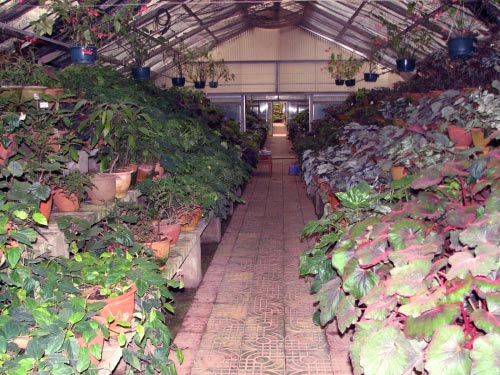 Begonia collection at Kunming Botanical Garden |
There are roughly 150 species of Begonia from China, those that are native to elevations of 5,000' and up are rare, but useful. A trip to the Kunming Botanical Garden in China impressed me with extensive greenhouses and lath houses dedicated to Begonia collection and breeding. When you look towards Begonia locales in South Africa or the Andes, you may find species living at 11,000' and above! Visitors to Machu Picchu report beautiful tuberous species of Begonias spilling from the cracks of the ruins. The Begonia species pearcii, veitchii, and boliviensis are all tuberous species living at cool, misty 10,000' elevation. Knowing this, you can understand why these plants do poorly in the American south with hot, humid nights foreign to these plants. These are the great-grandparents of many of the tuberous spp. we know today. It is my belief that through inbreeding and the introduction of different species, that most tuberous varieties have lost their hardiness. What I have seen in new collections from these high elevations is an increased ability to withstand cold.
What all hardy Begonias need is some sort of structure to store energy and food for the following year's growth. I had received a "hardy" Semperflorens begonia years ago, bred by Craig Walker. If you look at the roots of a normal "semp" begonia, they are fibrous. This one was different, with a definite fleshy "pseudo tuber" that insured new growth the following year. (See picture) Operating out of the USDA Research station in Poplarville, Mississippi, Dr. Cecil Pounders has done much breeding work with Begonias 'Kaylen', 'Barbara Rogers', B. cucullata, and B. fischeri - all showing levels of hardiness in the deep south. Dr. Pounders is doing a large number of crosses with ornamental cultivars to come up with varieties that are attractive and frost-hardy. In my recent trips to Texas and Alabama, I was surprised to find a number of rhizomatous species that took degrees of frost. Dawn Stover, a research associate with the SFA Mast Arboretum in Nagadoches was potting up a begonia with strong B. heracleifolia heritage on one of my stops there. She said that it's the one they call the "hardy" one down there. Tony Avent of Plant Delights nursery in North Carolina even lists B. heracleifolia 'Nigricans' as hardy to 15 degrees.
At issue is what varieties can take a northern winter? If you're talking zone 4 or 5 - you're out of luck. There are those who have surprising microclimates. I'll never forget that Cole Burrell had a hardy banana in Minnesota! I have even heard of South African Begonia sutherlandii thriving in a zone 5 garden under some pines! Back to our Google™ search, Begonia grandis is by far, the easiest hardy Begonia to find.
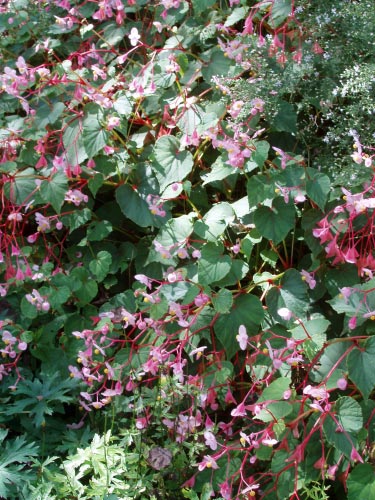 Begonia grandis in an Indianapolis garden |
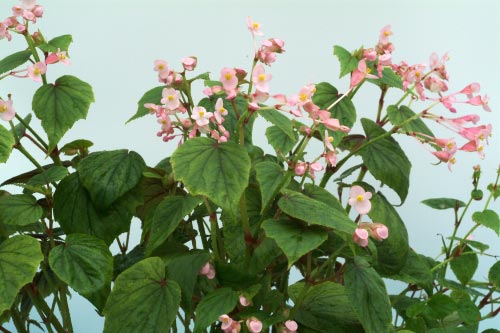 Begonia grandis in Oregon in August |
FORMS OF BEGONIA GRANDIS
All cultivars are hardy to zone 6. They prefer shade and free-draining, well-composted soils, and a slightly acidic soil around pH 6.0. They do well in competitive root situations. Height ranges from 15"-24" and flowers are typically few clustered, drooping and said to be fragrant.
Begonia grandis ssp. grandis (syn. evansiana) - a tuberous, deciduous herbaceous perennial having olive green leaves with red backs and/or red veins, pink flowers in fall var. alba - Light green leaves with veins red-netted on the back, white flowers in fall.
 Begonia grandis 'Claret Jug' |
Begonia grandis 'Claret Jug' - Smaller leaves with blood red backs. Better branched than the species and has pink flowers. British cultivar.
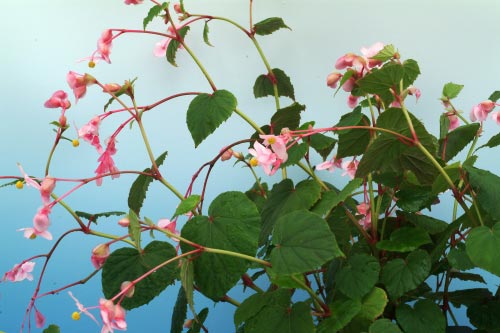 Begonia grandis 'Heron's Pirouette' |
Begonia grandis 'Heron's Pirouette' - collected in Japan by Dan Hinkley. Green leaves and larger pink flowers in large clusters.
Begonia grandis 'Pink Parasol' - A larger pink-flowered form than the species. collected by Bleddyn Wynn Jones in Shikoku, Japan. His nursery is Crug Farm in Wales.
Begonia grandis 'Sapporo' - a very vigorous Japanese selection form Japan's northernmost island. Very large, up to 36" in bloom! Joints are red.
Begonia grandis 'Simsii' - Larger in all aspects as the species
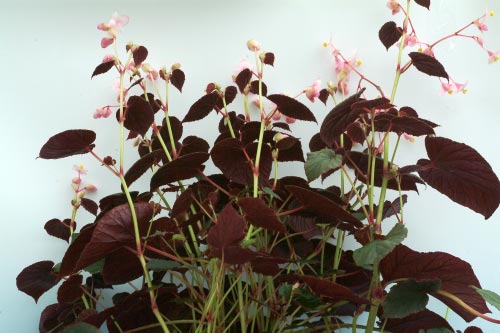 Begonia grandis 'Wildwood Splendor' |
Begonia grandis 'Wildwood Purity'
- yet another dark-backed form with large white flowers from breeder
Thurman Maness in Chapel Hill, NC.
Begonia grandis 'Wildwood Splendor' - another
dark-backed form with large pink flowers from breeder Thurman Maness
in Chapel Hill, NC.
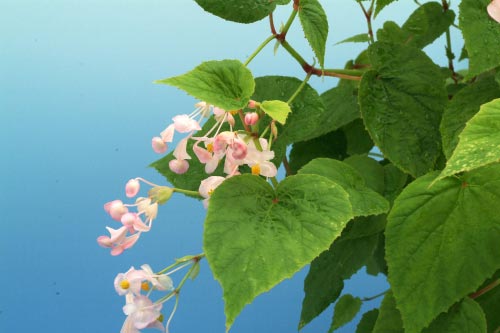 Begonia grandis ssp. sinensis |
Begonia grandis ssp. sinensis (syn. B. chinensis) - green leaves, and a mounding habit. Very petite when compared to the species. Light pink, small flowers.
Begonia grandis ssp. chinensis 'Red Undies' - a small dark-pink flowered selection collected by Bleddyn Wynn Jones in China. Leaves are red-backed. Low, mounding habit. From Crug Farm.
Begonia grandis ssp. chinensis 'Wolong Rose' - mounding form brought back by Darrel Probst form Szechuan, China.
Several hybrids have been made of B. grandis, but have not shown hardiness. I have been making numerous crosses to the best forms with other Chinese species and am very encouraged by the results.
Patent laws prevent me from providing photography and a full description. All I can tell you is there are some exciting plants in store!
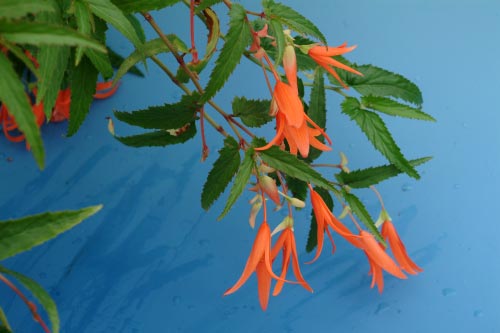 Begonia boliviensis |
Begonia boliviensis - a South American native to the Andes, this plant has been integral to a number of tuberous Begonia crosses. Orange flowers atop plants, 4' tall. Many of the new hybrids like B. 'Bonfire' show little hardiness. One does better by purchasing wild-collected plants like the ones from Plant Delights Nursery. Plants need a dry, well-drained spot in winter. Zone 7b.
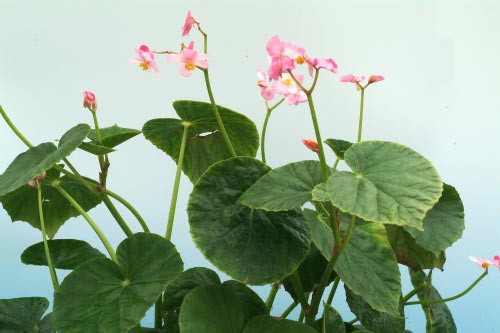 Begonia chitoensis |
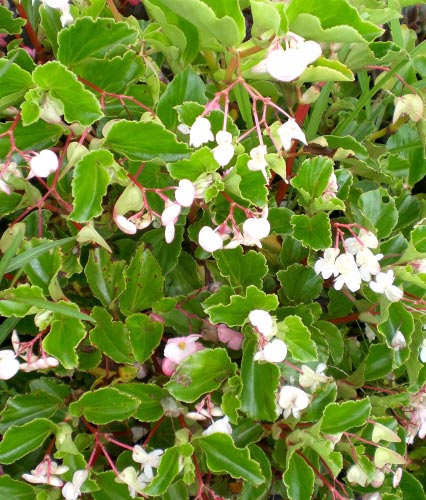 Begonia cucullata var. arenosicola |
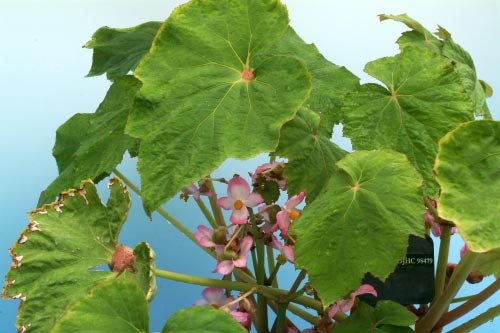 Begonia emeiensis |
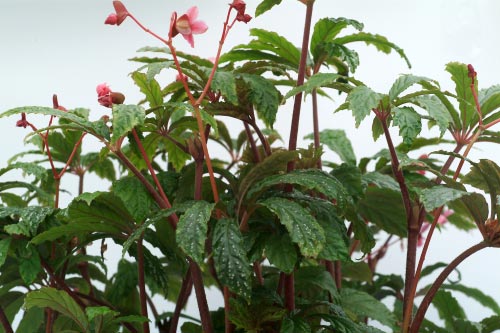 Begonia hemsleyana |
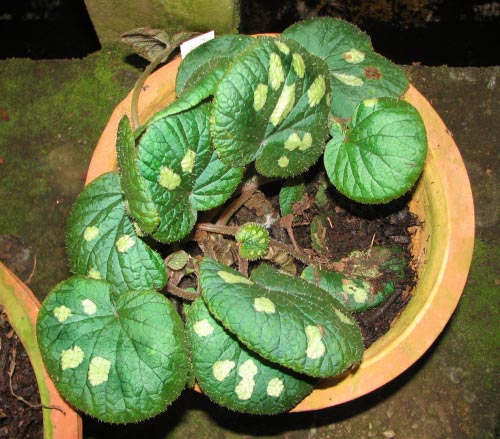 Begonia gulinquingensis |
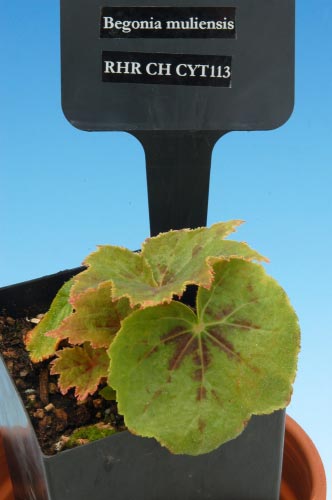 Begonia muliensis |
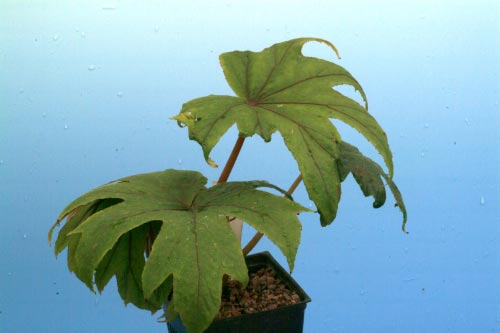 Begonia palmata |
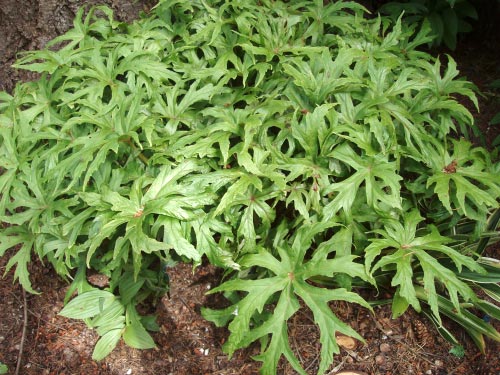 Begonia pedatifida |
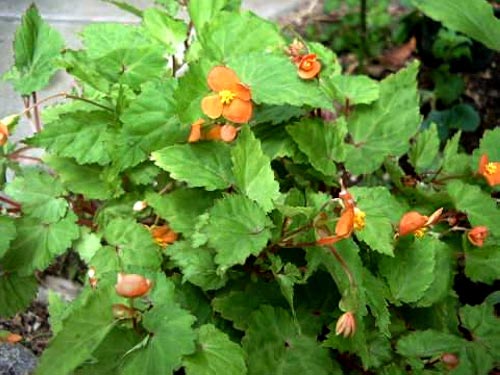 Begonia sutherlandii |
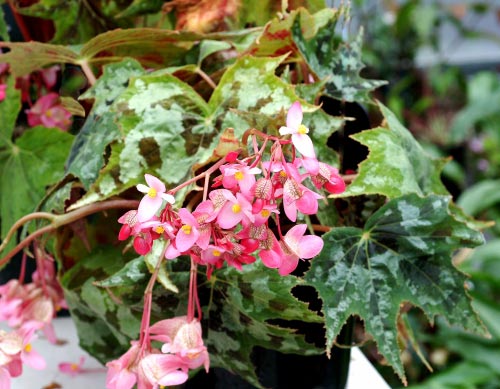 Begonia taliensis |
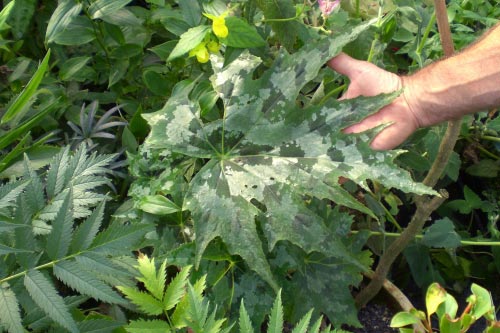 Begonia taliensis |
Begonia 'Barbara Rogers' - Barbara Rogers of Anderson, South Carolina had this white flowered Begonia which truly resembles a Semperflorens Begonia (but was found to be hardy to Zone 7b). This plant has dark green foliage and can reach 3' tall! This plant is sterile.
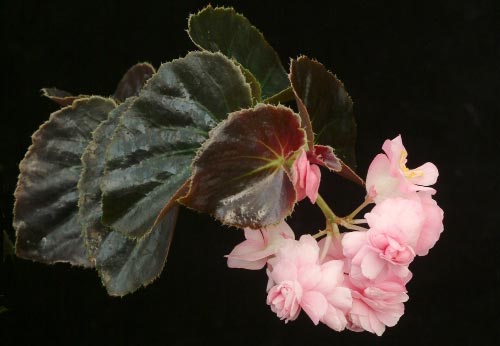 Begonia 'Cragmont' |
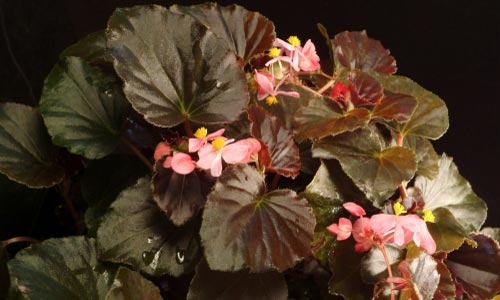 Begonia 'Kaylen' |
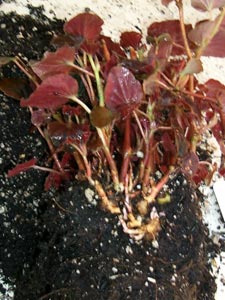 Begonia 'Kaylen' with winter storage "bulblets" |
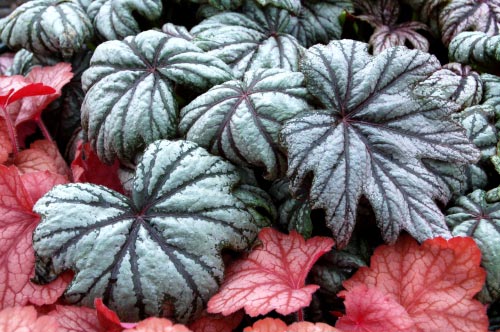 Begonia 'Metallic Mist' |
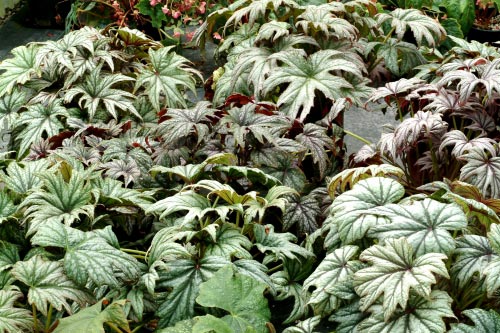 Begonia 'Metallic Mist' and siblings |
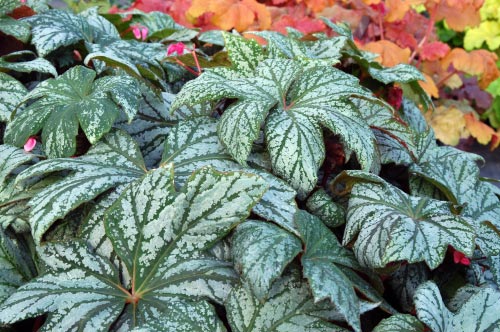 Begonia 'Silver Splendor' |
Many of the "hardy" forms can be kept in Northern climates in a cool garage or room that stays above 32 degrees. Do keep them on the dry side during their dormant period. With all of the new species being discovered, I can hope that there will be a new hardy Begonia coming to your garden very soon!
RESOURCES
Begonias Timber Press - Mark C. Tebbitt ISBN 0-88192-733-3
Begonias the Complete Reference Guide - Mildred Thompson ISBN 0-8129-0824-4
Encyclopedia of Begonia - Naoyuki Uemura (in Japanese w/ Latin) ISBN 4-416-40306-2
American Begonia Society - www.begonias.org
Begonias of China - http://flora.huh.harvard.edu/china/mss/volume13/Begoniaceae.pdf
RETAIL SOURCES
Plant Delights Nursery
www.plantdelights.com
Heronswood Nursery
www.heronswood.com
Green Thumbs Galore
www.greenthumbsgalore.com
Dutch Gardens
www.dutchgardens.com
Big Dipper Farm
www.bigdipperfarm.com
